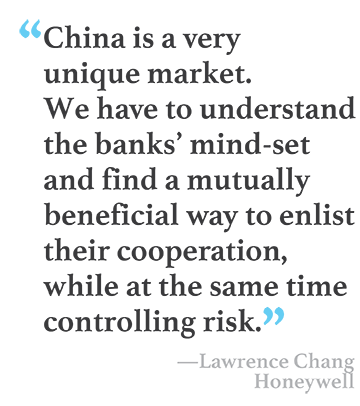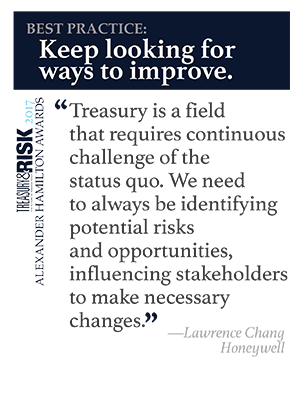
Honeywell has a significant—and expanding—presence in China. But managing a treasury function there requires creative thinking. “China is a very unique market,” says Lawrence Chang, China treasury manager for Honeywell. “Its banking system is different from those of other countries. We have to understand the banks' mind-set and find a mutually beneficial way to enlist their cooperation, while at the same time controlling risk.”
These were top-of-mind considerations when the global conglomerate looked at revamping its credit facilities in the country. Its Chinese businesses are cash-rich, but many require bank guaranties—such as warranty bonds, prepayment bonds, and performance bonds—as well as bank acceptance drafts, which are a standard method of payment within the Chinese auto industry. Historically, each of Honeywell's four legal entities in China maintained a separate line of credit with a local bank branch to issue these agreements.
Maintaining four separate lines of credit was inefficient, Chang explains: “From an operations perspective, we had four individual entities going through the same process with four different Bank of China branches. They would each negotiate bank fees individually and then go through the same internal approval and legal review processes.” There was a lot of duplication of activities in this environment.
 Moreover, Chang and his colleagues perceived that Honeywell was missing an opportunity to leverage its bargaining power at the corporate level. “In Chinese banks, each branch operates very autonomously,” he says. “Individual Honeywell legal entities were negotiating with their local Bank of China branches. By the time they notified us of an agreement, the contract would already be signed. In addition, without the presence of a country relationship manager, our communication with respective Bank of China branches was inefficient and time-consuming. We felt that Honeywell treasury, as a whole, could be getting a better deal by negotiating with a single Bank of China relationship manager.”
Moreover, Chang and his colleagues perceived that Honeywell was missing an opportunity to leverage its bargaining power at the corporate level. “In Chinese banks, each branch operates very autonomously,” he says. “Individual Honeywell legal entities were negotiating with their local Bank of China branches. By the time they notified us of an agreement, the contract would already be signed. In addition, without the presence of a country relationship manager, our communication with respective Bank of China branches was inefficient and time-consuming. We felt that Honeywell treasury, as a whole, could be getting a better deal by negotiating with a single Bank of China relationship manager.”
Thus, Honeywell's treasury group set out to develop an umbrella credit facility that all the company's legal entities in China could benefit from. Chang started the project by evaluating which Chinese banks could provide a facility structured in a way that would comply with Honeywell's credit policy and be managed by the company's regional center in Shanghai, while centralizing nationwide relationship management.
In addition, the treasury team needed to understand how the prospective umbrella facility would be reflected in the credit reference system for the People's Bank of China (PBOC). China's central bank requires all commercial banks to report their customers' credit events, then banks can log into the system to search companies' credit records. “Honeywell is unlikely to have a default,” Chang says. “Still, we needed to structure the umbrella facility so that if there was a default, it would go on the PBOC record for the participant rather than the holding company that signed the bank facility agreement.”
The Bank of China Shanghai branch met all of Honeywell's criteria. The bank had some prior experience establishing this type of umbrella line of credit with its multinational corporate and major state-owned customers, although the practice is rare within Bank of China. Structuring the Honeywell facility required customization and extensive negotiations to ensure that all aspects complied with the company's treasury policy and Bank of China's credit policy. Moreover, the Shanghai branch had to work with other Bank of China branches to integrate the existing lines of credit held by Honeywell's four business groups into the single umbrella facility.
Perhaps even more challenging was the internal communication needed to convince Honeywell business units to participate. Each participating group was required to sign a commitment that it wouldn't apply for a separate, individual banking facility.
“We put a lot of effort into persuading our internal stakeholders to support this idea,” Chang says. “We explained to them that although they were losing some control of their line of credit, the umbrella facility would be mutually beneficial. The individual entities would no longer have to go through the hassle of legal reviews and negotiations. We would be able to reduce bank fees by negotiating at the corporate level. And we would reduce their security deposits with the banks. Before this project, our business groups would sometimes have to put 100 percent cash of a bank guaranty into security deposit. That money would be stuck with the bank for the lifetime of the guaranty. Another advantage was that we would be able to leverage upon the country relationship manager to influence respective Bank of China branches.”
These extensive and deliberate communications were key to the project's success. “Through our internal and external communications, we were able to build up trust,” Chang reports. “Without trust between Honeywell and the Bank of China, or without the trust between treasury and all the stakeholders within Honeywell's finance staff across China, the umbrella credit facility wouldn't have happened.”
By explaining the projected benefits, and enrolling the support of senior leadership within Honeywell, Chang's group convinced 20 business units to participate in an umbrella facility worth CNY1 billion. “This amount provides us comfortable headroom to accommodate our expansion in China,” Chang says. The treasury group allocates portions of the facility to participants based on the annual forecast of each business unit's finance leader, and Bank of China Shanghai distributes the credit limits to other Bank of China branches based on treasury's allocations.
“Sometimes Company A may have stronger business growth, and we can easily adjust the facility to accommodate that,” Chang says. “Each entity maintains a local Bank of China account. Bank of China Shanghai can charge the bank guaranty fee to our centralized holding company, which is the entity signing the bank facility agreement. Then Bank of China Shanghai can allocate the facility to the appropriate branch for each participating Honeywell entity. Upon the implementation of the umbrella credit facility, we were able to release our security deposits with Bank of China and contributed around US$630,000 incremental interest income per year.”
 Not only has the umbrella facility improved the company's operational efficiency, but it has also reduced risk. “Before, it was possible that an entity might sign up for a product or service that corporate treasury was not aware of,” Chang says. “Business units that may not have had as much specialized expertise in these areas were reviewing commercial terms and legal terms, and negotiating with banks. This incurred a risk to Honeywell as a group, even up to the parent company in the United States. This project mitigated that risk by centralizing negotiations and approvals with corporate treasury and releasing our business finance teams to focus on delivering on their P&L commitments.”
Not only has the umbrella facility improved the company's operational efficiency, but it has also reduced risk. “Before, it was possible that an entity might sign up for a product or service that corporate treasury was not aware of,” Chang says. “Business units that may not have had as much specialized expertise in these areas were reviewing commercial terms and legal terms, and negotiating with banks. This incurred a risk to Honeywell as a group, even up to the parent company in the United States. This project mitigated that risk by centralizing negotiations and approvals with corporate treasury and releasing our business finance teams to focus on delivering on their P&L commitments.”
Ultimately, Chang sees this project as exemplifying the thought leadership role the treasury team can play within an organization. “Treasury is a field that requires continuous challenge of the status quo,” Chang says. “We need to always be identifying potential risks and opportunities, influencing stakeholders to make necessary changes. The umbrella credit facility has provided such great benefit that our finance organization places more trust in corporate treasury. When treasury-related issues come up now, they consult with us instead of just going forward on their own.”
2017 Alexander Hamilton Awards — Best Practices in Restricted/Emerging Markets
- Silver: Pfizer | Transition to the CNY
- Bronze: World Vision International | A Treasury with Global Vision
Complete your profile to continue reading and get FREE access to Treasury & Risk, part of your ALM digital membership.
Your access to unlimited Treasury & Risk content isn’t changing.
Once you are an ALM digital member, you’ll receive:
- Thought leadership on regulatory changes, economic trends, corporate success stories, and tactical solutions for treasurers, CFOs, risk managers, controllers, and other finance professionals
- Informative weekly newsletter featuring news, analysis, real-world case studies, and other critical content
- Educational webcasts, white papers, and ebooks from industry thought leaders
- Critical coverage of the employee benefits and financial advisory markets on our other ALM sites, PropertyCasualty360 and ThinkAdvisor
Already have an account? Sign In Now
*May exclude premium content© 2025 ALM Global, LLC, All Rights Reserved. Request academic re-use from www.copyright.com. All other uses, submit a request to [email protected]. For more information visit Asset & Logo Licensing.





